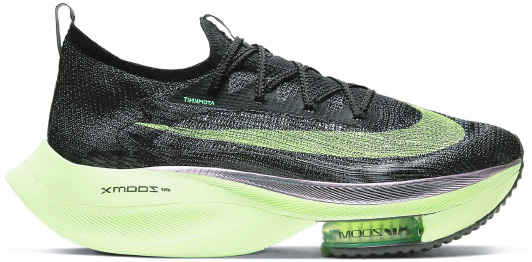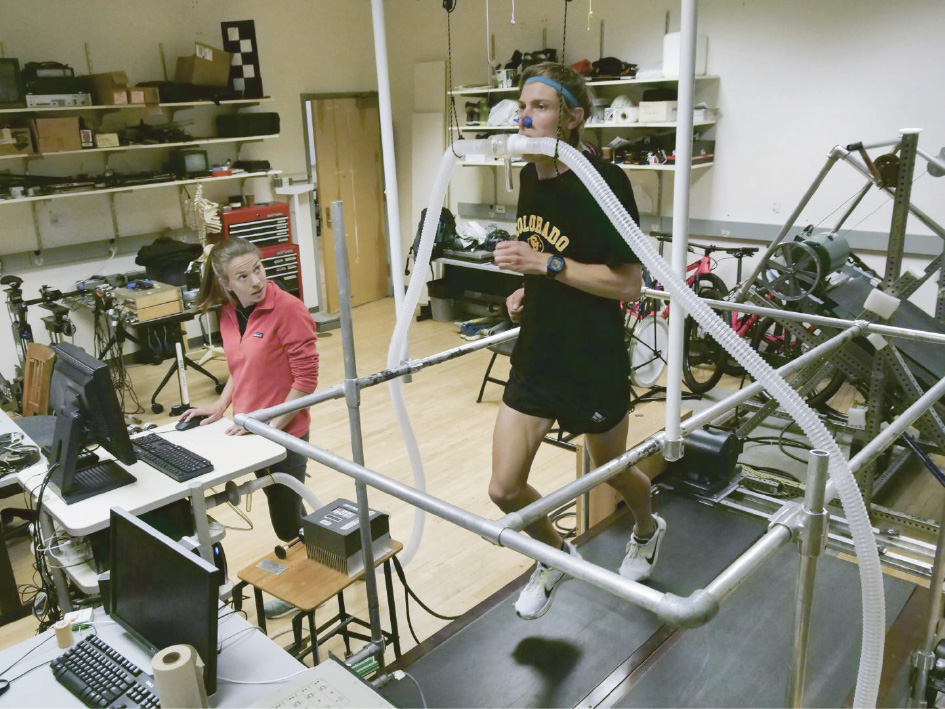Athletes are constantly looking to advances in technology to gain a competitive advantage, to jump just a bit higher, to hit a ball just a bit farther, and to return a serve just a bit quicker. But sometimes a technical innovation comes along that temporarily breaks a sport. Thanks to adaptive suspension and computer-aided steering developed in the 1980s, Formula One racing cars became incredibly fast, but also so dangerous that the sport’s governing body banned the technology in 1994. In 2008 and 2009, swimmers wearing the now-barred LZR Racer swimsuit line from the swimwear company Speedo shattered 130 of the 134 world records for competitive swimming.
Now, the world of marathon running is facing its own disruptive moment, thanks to the Air Zoom Alphafly Next% (Fig. 1), a new high-performance shoe from the footwear and sporting-goods giant Nike, headquartered in Beaverton, OR, USA. The new shoe, which combines a wedge of energy-returning foam with a stabilizing carbon-fiber plate and a pair of air-filled sacs in the forefoot, played a significant part in Kenyan runner Eliud Kipchoge running the world’s first sub-two-hour marathon in 2019 fall.
《Fig. 1》

Fig. 1. Elite runners wearing state-of-the-art Nike Air Zoom Alphafly NEXT% running shoes are breaking long-standing records. The shoes feature a generous wedge of ZoomX (polyether block amide) foam bisected with a full-length internal curved carbon-fiber plate and a pair of Zoom Air Pods in the forefoot. Credit: Nike (public domain).
For the better part of 40 years, the vast majority of running shoes have been built atop a foam sole made of ethylene-vinyl acetate (EVA). EVA owes its dominance and longevity to being lightweight, cheap, and easy to work with. However, it is not great in terms of energy return, or "bounce back” following each footfall. EVA foam returns about 65% of this energy, giving shoes made with the material a modest energy return/bounce back. In 2013, Nike-competitor, Germany-based Adidas began producing shoe lines incorporating a foam made of thermoplastic polyurethane (TPU), which has an energy return between 70% and 75%. In 2017, Nike released the first version of its Vaporfly line—Alphafly’s predecessor—using a foam derived from polyether block amide (Pebax). Pebax, or ZoomX as Nike calls it, has an energy return of 87% [1]. Pebax is also less dense than EVA and TPU, and therefore also weighs less.
"So, it returns substantially more energy and costs less energy to carry it on your foot,” said Geoff Burns, a research fellow at the University of Michigan Performance Research Laboratory. "It is like having your cake and eating it, too.”
On its own, however, Pebax is not ideal for running shoes because, despite its favorable properties, it is extremely squishy. "That makes it kind of unstable if you are trying to go fast, like running on a marshmallow,” Burns said.
To help stabilize the Vaporfly and coordinate the foot’s mechanics in an efficient way, Nike engineers inserted a carbon-fiber plate through the middle of the foam. "The foam by itself probably would not be that beneficial and the carbon fiber by itself is not really that beneficial,” Burns said. "But those two things together obviously produce something special.”
And not just any carbon-fiber plate will do. Flat plates make no difference in running economy—the amount of metabolic energy required to run at a specific velocity. The plate needs to adopt a subtle "S”-shape to be effective [2]. "What is clever about the curve is that it does not increase the lever arm about the ankle joint that the calf muscles have to overcome,” said Rodger Kram, an associate professor emeritus of integrative physiology at the University of Colorado, Boulder. The result is less overall energy used by the runner. The pair of air-filled sacs in the forefoot of the Alphafly, which Nike calls Zoom Air Pods, add cushioning and further increase the energy return.
In 2018, Kram’s laboratory reported that the Vaporfly decreased a measure of the energetic cost of running, called oxygen cost transport, by 4% (Fig. 2) [1]. Due in part to factors such as air resistance, the metabolic energy required to run faster is not perfectly linear, so 4% energy savings translates to an estimated 2.5%–3.5% increase in running velocity for a typical elite marathon runner.
《Fig. 2》

Fig. 2. Shalaya Kipp, a research technician in the Locomotion Laboratory at the University of Colorado, Boulder, conducts a treadmill test to measure the energetic cost of running. Such tests showed an average 4% improvement in running economy for runners wearing Nike Vaporfly running shoes [1]. Credit: CU Boulder (public domain).
"Even with a 2% improvement in running economy, you’re looking at nearly two minutes taken off a marathon time,” said Iain Hunter, a professor of exercise science at Brigham Young University in Provo, UT, USA. ‘‘Two minutes can be the difference between a gold medal and not getting a medal or making an Olympic team and not making an Olympic team.”
And, indeed, this difference has upended the sport. The winner of the first marathon at the 1896 Olympics ran a time of 2 h, 58 min, and 50 s (2:58:50). Over the course of the next century, marathoners have incrementally reduced this run time by nearly 1 h. On 12 October 2019, Kipchoge broke the elusive 2 h mark in a controlled setting in Vienna, clocking in at 1:59:40 in a prototype of Nike’s Alphafly Next% shoe. The next day, wearing a pair of Nike Vaporflys, fellow Kenyan runner Brigid Kosgei ran 2:14:4 at the Chicago Marathon, crushing the women’s world record that had stood for 16 years by 81 s. Throughout 2019, 31 of the 36 runners to earn podium slots across the six men’s and women’s world major marathon events wore Vaporflys. Nike has also applied its Next% technology to a spiked shoe (the Nike Air Zoom Victory) intended for race distances of 800–10 000 m, but its impact on these shorter running events remains to be seen.
And it is not just world champion runners who experience the benefits. A 2018 analysis of 500 000 marathon and half-marathon times over the prior three years revealed that people wearing the Vaporfly were 3%–4% faster than those wearing other shoes [3]. A more recent study found that advantage might be closer to 4%–5% [4]. Slower runners, those who move at speeds around 9 min·mi-1 (5.6 min·km-1 ), receive relatively higher performance boosts from the Vaporfly than the fastest runners at closer to 4 min·mi-1 (2.5 min·km-1 ) [5].
In an apparent attempt to reset the competitive balance, World Athletics—the governing body of several racing sports, including long-distance running—released guidelines in late January that impose an immediate ban on any shoe with a sole thicker than 40 mm or shoes that contain more than one carbon-fiber plate. Less than a week later, Nike announced that a consumer version of the Alphafly Next% would be available later this year [6]. In addition to the pair of Zoom Air Pods in the forefoot, the shoe bears a single carbon-fiber plate and has a sole thickness of 39.5 mm.
"The curious timing here led many to call foul and speculate collusion. Regardless, I was happy to see explicit design requirements finally come out,” Burns said. "The next step is creating optimal configurations for each individual—different plate architectures and different foam compliances. There is a lot of ground to be made personalizing the advantage these shoes provide.”













 京公网安备 11010502051620号
京公网安备 11010502051620号




